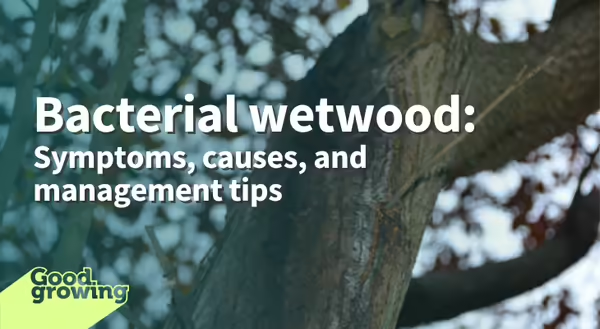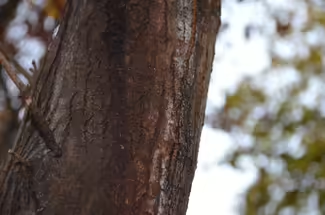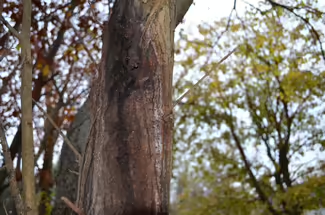
As the autumn leaves fall from our trees, the trunk and branching structure become more prominent and visible. This transformation can add new dimensions and interest to a landscape, but it can also draw our attention to tree health challenges we might have overlooked in other seasons. As we observe the trees in our landscape and community, bacterial wetwood may be a common observation.
Bacterial Wetwood
Also known as wetwood or slime-flux, bacterial wetwood is a water-soaked condition of wood that can occur in the heartwood of tree trunks, roots, and branches. The affected wood is not actively growing, usually at or near anaerobic conditions (without oxygen), and is often made susceptible due to a previous wound.
Bacterial wetwood occurs when a tree wound is infected by one or more species of bacteria. The bacteria associated with bacterial wetwood, including Enterobacterium, Klebsiella, and Pseudomonas, are commonly found in soil and can easily infect a tree through a root wound. These infections are usually limited to the sapwood and heartwood.
As bacteria activity progresses, excess sap is produced which ferments, creating gases and a build-up of pressure within the interior of the tree. As internal pressure builds, moisture is pushed out, typically near a small wound in the trunk, causing an oozing or bleeding of liquid out of the tree. The liquid seeping from the water-soaked heartwood (wetwood) is known as slime-flux and may emit a foul odor. Bacterial activity is highest during summer months therefore symptoms of oozing and odor are more prevalent during this time.
Areas of a tree affected by bacterial wetwood appear dark-brown to black as if waterlogged. The shape and size of the discoloration are irregular and vary. The seeping liquid is toxic to plants and has the potential to be transported though the plant’s vascular system to other locations within the tree. Branches affected by bacterial wetwood may exhibit symptoms of wilting, defoliation, or dieback.
Affected Species
Although a wide range of tree species are susceptible to bacterial wetwood, a few species in our landscape are affected with greater frequency. Multiple sources referenced occurrence on elm (Ulmus) ad poplar (Populus) as the most common species to exhibit symptoms of bacterial wetwood. Other species commonly susceptible include crabapple (Malus), maple (Acer), beech (Fagus), mulberry (Morus) and oak (Quercus). It is unclear as to why these species are at greater risk of developing although it appears that faster-growing species are more susceptible.
Treatment
There is no recommended method of control or treatment for bacterial wetwood. However, prevention through proper care practices that maintain health and vigor can reduce a tree’s risk of infection. Following best practices for pruning, including careful decision-making, timing, and technique help lower infection risk.
Removing dead and diseased plant material is always recommended. If bacterial wetwood occurs on lateral branches, it is recommended that those be removed using sterilized tools and proper pruning techniques.
When bacterial wetwood infections occur on the trunk of a tree, there is little to be done for management. At one time, it was recommended that drainage tubes be inserted into the wound with the intention of relieving pressure, but this is no longer recommended. Inserting tubes into a wound increases the likelihood of spreading the disease, resulting in more harm being done than benefit achieved.
Bacterial wetwood is considered a chronic disease of trees, not fatal. Over time, bacterial wetwood can contribute to a tree’s decline through reduced vigor, increased stress, and increased susceptibility to other pests and pathogens. For landscape trees, bacterial wetwood is unsightly but rarely warrants removal. For lumber production, bacterial wetwood reduces the value of logs as it changes the look and composition of the wood.
Good Growing Fact of the Week: Depending on the species, the water content in wetwood may be up to 80% greater than that of normal sapwood content.
Thank you for reading!
Sign up for our emails! Want to get notified when new Good Growing posts are available? SIGN ME UP
Give us feedback! How helpful was this information (click one): Very helpful | Somewhat helpful | Not very helpful
MEET THE AUTHOR
Emily Swihart is a horticulture educator with University of Illinois Extension, serving Henry, Mercer, Rock Island, and Stark counties since 2021. Emily provides horticulture programming with an emphasis on the home gardener, the urban forest, native plant ecosystems, and landscape design. Additional responsibilities include supporting local county Master Gardener and Master Naturalist volunteers - providing training, continuing education, advanced training, and their involvement in seasonal events and community outreach programs.


